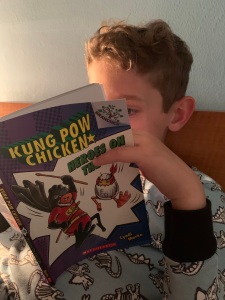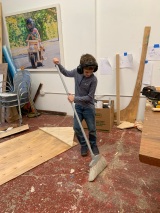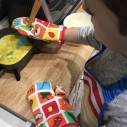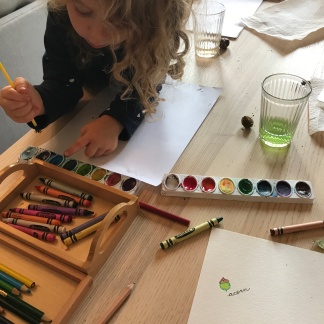
I recently shared our 2019-2020 wrap-up and curriculum review. I am excited to share what we will be doing this year! First, we have actually already started. Since we are home so much because of Corona, I decided to get a jump start on the new year. Hopefully this will give us a chance to take off a big chunk of time during the holidays where we can bake and make crafts, all with zero guilt.
This year Ethan (7.5) will be in 3rd grade and Lillian (6) will be in 1st grade. Here are our plans by subject:
Arithmetic
1st Grade

We will be using Master Books Math: Lessons for a Living Education Volume 1. I loved Volume 2 for Ethan last year. I think Lillian will love the story portion of the lesson, the color pictures and the gentle pace.
Along with the gentle pace comes plenty of time for her to use our Montessori Math Materials. We will be using the Addition Strip Board, Teens Board, Tens Board, Hundred Chain, Thousand Chain, 45 Layout Mat and the Stamp Game.
3rd Grade
This will be our first year using Beast Academy Math.

I purchased both the online version and the workbooks. At first we started with just the online version. But I think since we are very low-tech, Ethan was struggling a bit with solving his problems on the computer. So I ordered the workbook so he has an area to practice with paper and pencil too. Although in a little over a week, he has really already improved with using the computer.
I love the challenging aspect of Beast Academy and I think using Montessori materials prior to this helped him develop a super strong number sense. He is doing great with the challenging problems on Beast Academy because his fundamental math skills are so strong – particularly place value work.
I probably never would have chosen a curriculum called Beast Academy if I did not have a 7 year old boy. The name probably would have turned me off. But I get it now and the monster appeal is huge!
BOTH GRADES
We are using the book Addition Facts that Stick by Kate Snow as part of our Morning Basket. So far this is just review for Ethan but I don’t mind the extra practice and it’s been great for Lillian.
English Language Arts
1st Grade
I am going to useThe Good and The Beautiful with Lillian this year. This will be our first time trying out one of their products. Since we are a secular homeschool I know I might have to change or omit some things but I’m really not worried about that. We will also continue to work with Montessori Language Work, read BOB books and continue using Spelling You See Level B Book 1.

3rd Grade
This is a real hodgepodge but I feel will be best for Ethan and the learning goals I have in mind for him this year. We are using:
Comprehension Skills: Short Passages for Close Reading by Scholastic
Grammar Tales by Scholastic
Daily Word Ladders Grades 2-3: Word Study Lessons that Boost Reading, Vocabulary, Spelling & Phonics by Scholastic
Spelling You See – Level B Book 2
We may also use the The Brave Writer Dart Program single issue in May.

BOTH GRADES
I read aloud daily 2 picture books, 2 poems and a few chapters of whatever chapter book we are reading. Both kids also love listening to audiobooks and read independently every day. We have Poetry Tea Time once a week and the kids enjoy using Reading Eggs/ Reading Eggspress from time to time.
Handwriting
Both kids are going to continue with Handwriting Without Tears. If Ethan moves quickly through his book, we will add in Keyboarding Without Tears when he is finished.
History & Geography
We are moving on to Story of the World Volume 2. We loved Volume 1 and are excited to continue with this program.
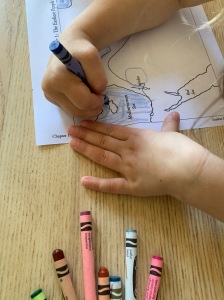
Science
Our science plans in the past have usually all been outsourced: forest school, Brooklyn Robot Foundry and Boat Building Class. But this year I am going to try an official Science curriculum for the first time. We will be using Pandia Press Real Science Odyssey – Astronomy. It is Level One for Grades 1-4. I’m a little nervous about finding the time to add this in but also excited to have found a secular science program that looks awesome! It includes lessons, lab experiments and worksheets.
Art
We are trying something new this year! I purchased 2 Picture Study Portfolios from Simply Charlotte Mason. We are going to study Vermeer and Michaelangelo.
Music
We are using another product from Simply Charlotte Mason called Music Study with the Masters to study the composers, Schubert and Lizst.
Outside Activities
Oh, are the choices slim this year thanks to Corona. We are going to continue meeting with our Wild + Free Group for free play in nature with friends and Zoom Tae Kwon Do lessons.
Misc
I always leave time to add in special studies of what each child is interested in and will accommodate that through the books I choose to read aloud, copy work, art projects, field trips or Outschool classes. We also always incorporate special seasonal studies for fall, Halloween, Thanksgiving, Hanukkah and Christmas. I will make a post about this seasonal schooling soon! And of course, just like everyone else, I have no idea how Corona will impact or change any or all of these plans! Will museums be open? Will we want to ride the subway? And the list goes on and on.
But, this is our plan as of right now! One of the best parts of homeschooling is the ability to adapt, change and evolve whenever you need to do so.



















